LAW6000 Business & Corporate Law: In-Depth Case Study Analysis Report
VerifiedAdded on 2023/01/23
|9
|2093
|34
Case Study
AI Summary
This document presents solutions to four case studies related to business and corporate law. The first solution analyzes whether a binding contract exists between Jeff and Tina, focusing on the implications of solicitor approval and finance conditions. The second solution examines the liabilities of Phil and Robert as directors of LightsBright Pty Ltd and CheepCheep, respectively, addressing breaches of duty and the potential application of the business judgment rule. The third solution explores agency law, determining whether Francis is bound by Rick's actions in purchasing Kiss and Status Quo albums and the potential repercussions for Rick. Finally, the fourth solution assesses a negligence claim against RuPeter and a hotel, focusing on the damages that can be sought by Prue due to injuries sustained from a contaminated gown. This comprehensive analysis provides valuable insights into contract law, directors' duties, agency principles, and negligence, offering practical advice and conclusions based on legal principles and case precedents. Desklib offers a range of solved assignments and resources for students.
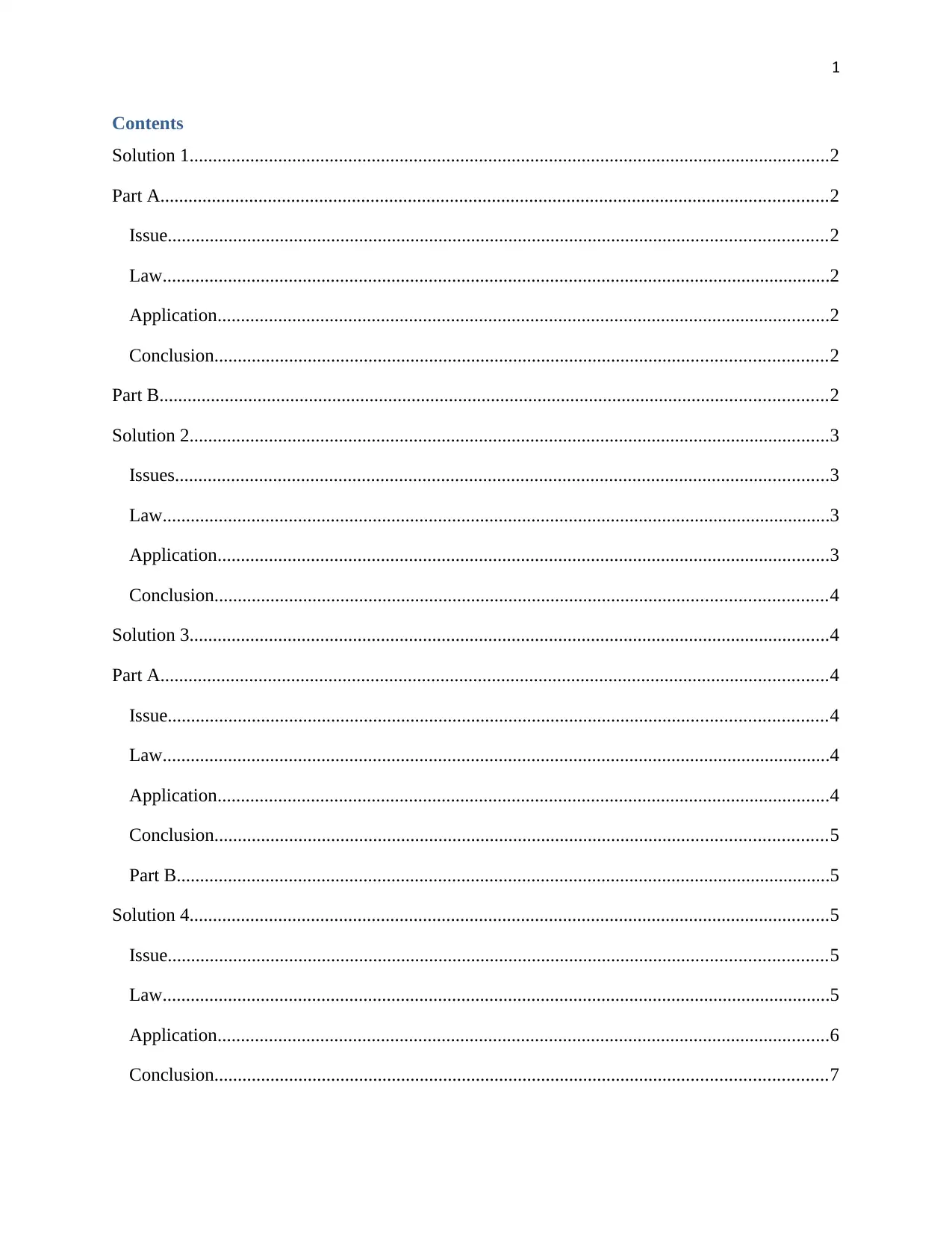
1
Contents
Solution 1.........................................................................................................................................2
Part A...............................................................................................................................................2
Issue.............................................................................................................................................2
Law...............................................................................................................................................2
Application...................................................................................................................................2
Conclusion...................................................................................................................................2
Part B...............................................................................................................................................2
Solution 2.........................................................................................................................................3
Issues............................................................................................................................................3
Law...............................................................................................................................................3
Application...................................................................................................................................3
Conclusion...................................................................................................................................4
Solution 3.........................................................................................................................................4
Part A...............................................................................................................................................4
Issue.............................................................................................................................................4
Law...............................................................................................................................................4
Application...................................................................................................................................4
Conclusion...................................................................................................................................5
Part B............................................................................................................................................5
Solution 4.........................................................................................................................................5
Issue.............................................................................................................................................5
Law...............................................................................................................................................5
Application...................................................................................................................................6
Conclusion...................................................................................................................................7
Contents
Solution 1.........................................................................................................................................2
Part A...............................................................................................................................................2
Issue.............................................................................................................................................2
Law...............................................................................................................................................2
Application...................................................................................................................................2
Conclusion...................................................................................................................................2
Part B...............................................................................................................................................2
Solution 2.........................................................................................................................................3
Issues............................................................................................................................................3
Law...............................................................................................................................................3
Application...................................................................................................................................3
Conclusion...................................................................................................................................4
Solution 3.........................................................................................................................................4
Part A...............................................................................................................................................4
Issue.............................................................................................................................................4
Law...............................................................................................................................................4
Application...................................................................................................................................4
Conclusion...................................................................................................................................5
Part B............................................................................................................................................5
Solution 4.........................................................................................................................................5
Issue.............................................................................................................................................5
Law...............................................................................................................................................5
Application...................................................................................................................................6
Conclusion...................................................................................................................................7
Paraphrase This Document
Need a fresh take? Get an instant paraphrase of this document with our AI Paraphraser

2
Reference List..................................................................................................................................8
Reference List..................................................................................................................................8
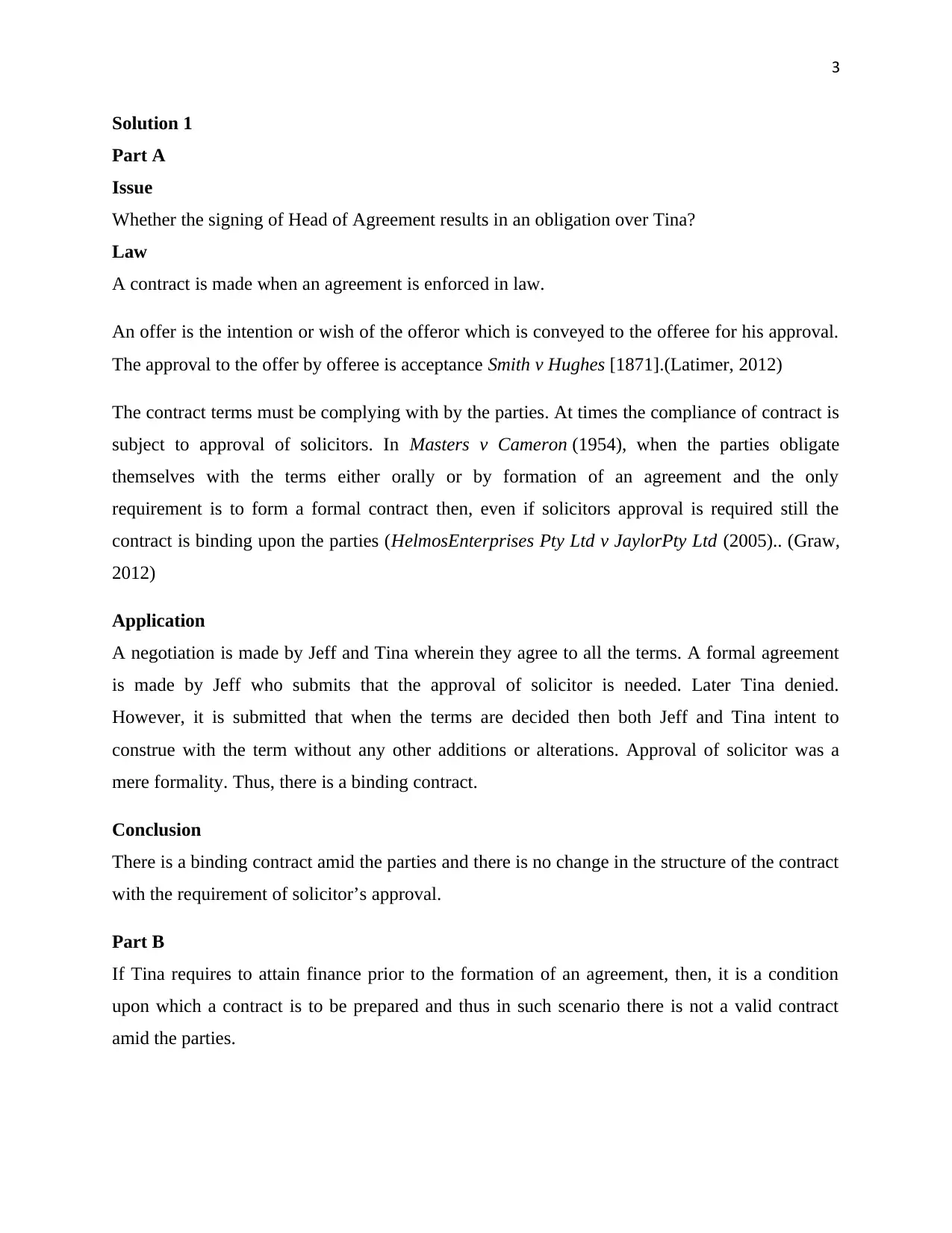
3
Solution 1
Part A
Issue
Whether the signing of Head of Agreement results in an obligation over Tina?
Law
A contract is made when an agreement is enforced in law.
An offer is the intention or wish of the offeror which is conveyed to the offeree for his approval.
The approval to the offer by offeree is acceptance Smith v Hughes [1871].(Latimer, 2012)
The contract terms must be complying with by the parties. At times the compliance of contract is
subject to approval of solicitors. In Masters v Cameron (1954), when the parties obligate
themselves with the terms either orally or by formation of an agreement and the only
requirement is to form a formal contract then, even if solicitors approval is required still the
contract is binding upon the parties (HelmosEnterprises Pty Ltd v JaylorPty Ltd (2005).. (Graw,
2012)
Application
A negotiation is made by Jeff and Tina wherein they agree to all the terms. A formal agreement
is made by Jeff who submits that the approval of solicitor is needed. Later Tina denied.
However, it is submitted that when the terms are decided then both Jeff and Tina intent to
construe with the term without any other additions or alterations. Approval of solicitor was a
mere formality. Thus, there is a binding contract.
Conclusion
There is a binding contract amid the parties and there is no change in the structure of the contract
with the requirement of solicitor’s approval.
Part B
If Tina requires to attain finance prior to the formation of an agreement, then, it is a condition
upon which a contract is to be prepared and thus in such scenario there is not a valid contract
amid the parties.
Solution 1
Part A
Issue
Whether the signing of Head of Agreement results in an obligation over Tina?
Law
A contract is made when an agreement is enforced in law.
An offer is the intention or wish of the offeror which is conveyed to the offeree for his approval.
The approval to the offer by offeree is acceptance Smith v Hughes [1871].(Latimer, 2012)
The contract terms must be complying with by the parties. At times the compliance of contract is
subject to approval of solicitors. In Masters v Cameron (1954), when the parties obligate
themselves with the terms either orally or by formation of an agreement and the only
requirement is to form a formal contract then, even if solicitors approval is required still the
contract is binding upon the parties (HelmosEnterprises Pty Ltd v JaylorPty Ltd (2005).. (Graw,
2012)
Application
A negotiation is made by Jeff and Tina wherein they agree to all the terms. A formal agreement
is made by Jeff who submits that the approval of solicitor is needed. Later Tina denied.
However, it is submitted that when the terms are decided then both Jeff and Tina intent to
construe with the term without any other additions or alterations. Approval of solicitor was a
mere formality. Thus, there is a binding contract.
Conclusion
There is a binding contract amid the parties and there is no change in the structure of the contract
with the requirement of solicitor’s approval.
Part B
If Tina requires to attain finance prior to the formation of an agreement, then, it is a condition
upon which a contract is to be prepared and thus in such scenario there is not a valid contract
amid the parties.
⊘ This is a preview!⊘
Do you want full access?
Subscribe today to unlock all pages.

Trusted by 1+ million students worldwide
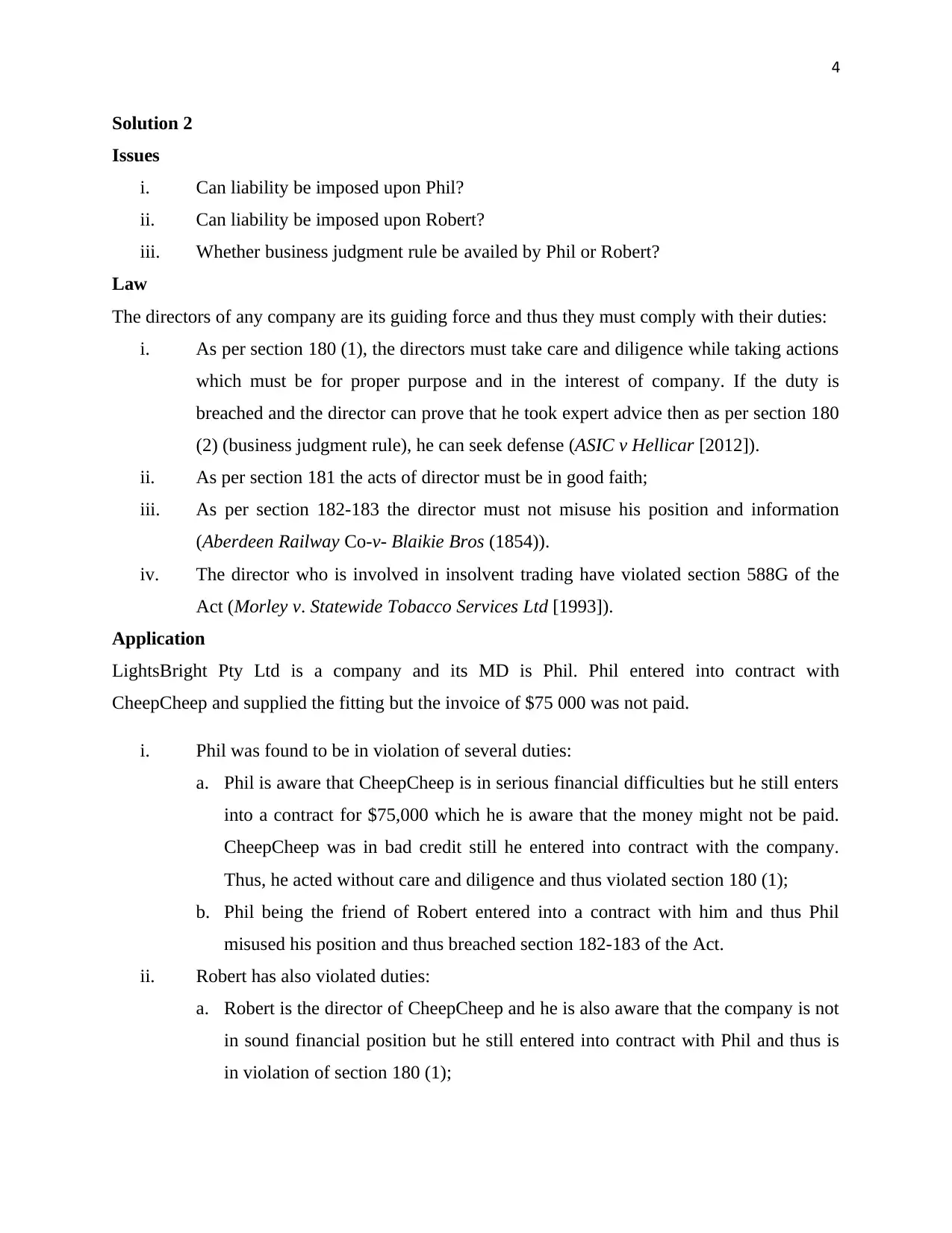
4
Solution 2
Issues
i. Can liability be imposed upon Phil?
ii. Can liability be imposed upon Robert?
iii. Whether business judgment rule be availed by Phil or Robert?
Law
The directors of any company are its guiding force and thus they must comply with their duties:
i. As per section 180 (1), the directors must take care and diligence while taking actions
which must be for proper purpose and in the interest of company. If the duty is
breached and the director can prove that he took expert advice then as per section 180
(2) (business judgment rule), he can seek defense (ASIC v Hellicar [2012]).
ii. As per section 181 the acts of director must be in good faith;
iii. As per section 182-183 the director must not misuse his position and information
(Aberdeen Railway Co-v- Blaikie Bros (1854)).
iv. The director who is involved in insolvent trading have violated section 588G of the
Act (Morley v. Statewide Tobacco Services Ltd [1993]).
Application
LightsBright Pty Ltd is a company and its MD is Phil. Phil entered into contract with
CheepCheep and supplied the fitting but the invoice of $75 000 was not paid.
i. Phil was found to be in violation of several duties:
a. Phil is aware that CheepCheep is in serious financial difficulties but he still enters
into a contract for $75,000 which he is aware that the money might not be paid.
CheepCheep was in bad credit still he entered into contract with the company.
Thus, he acted without care and diligence and thus violated section 180 (1);
b. Phil being the friend of Robert entered into a contract with him and thus Phil
misused his position and thus breached section 182-183 of the Act.
ii. Robert has also violated duties:
a. Robert is the director of CheepCheep and he is also aware that the company is not
in sound financial position but he still entered into contract with Phil and thus is
in violation of section 180 (1);
Solution 2
Issues
i. Can liability be imposed upon Phil?
ii. Can liability be imposed upon Robert?
iii. Whether business judgment rule be availed by Phil or Robert?
Law
The directors of any company are its guiding force and thus they must comply with their duties:
i. As per section 180 (1), the directors must take care and diligence while taking actions
which must be for proper purpose and in the interest of company. If the duty is
breached and the director can prove that he took expert advice then as per section 180
(2) (business judgment rule), he can seek defense (ASIC v Hellicar [2012]).
ii. As per section 181 the acts of director must be in good faith;
iii. As per section 182-183 the director must not misuse his position and information
(Aberdeen Railway Co-v- Blaikie Bros (1854)).
iv. The director who is involved in insolvent trading have violated section 588G of the
Act (Morley v. Statewide Tobacco Services Ltd [1993]).
Application
LightsBright Pty Ltd is a company and its MD is Phil. Phil entered into contract with
CheepCheep and supplied the fitting but the invoice of $75 000 was not paid.
i. Phil was found to be in violation of several duties:
a. Phil is aware that CheepCheep is in serious financial difficulties but he still enters
into a contract for $75,000 which he is aware that the money might not be paid.
CheepCheep was in bad credit still he entered into contract with the company.
Thus, he acted without care and diligence and thus violated section 180 (1);
b. Phil being the friend of Robert entered into a contract with him and thus Phil
misused his position and thus breached section 182-183 of the Act.
ii. Robert has also violated duties:
a. Robert is the director of CheepCheep and he is also aware that the company is not
in sound financial position but he still entered into contract with Phil and thus is
in violation of section 180 (1);
Paraphrase This Document
Need a fresh take? Get an instant paraphrase of this document with our AI Paraphraser
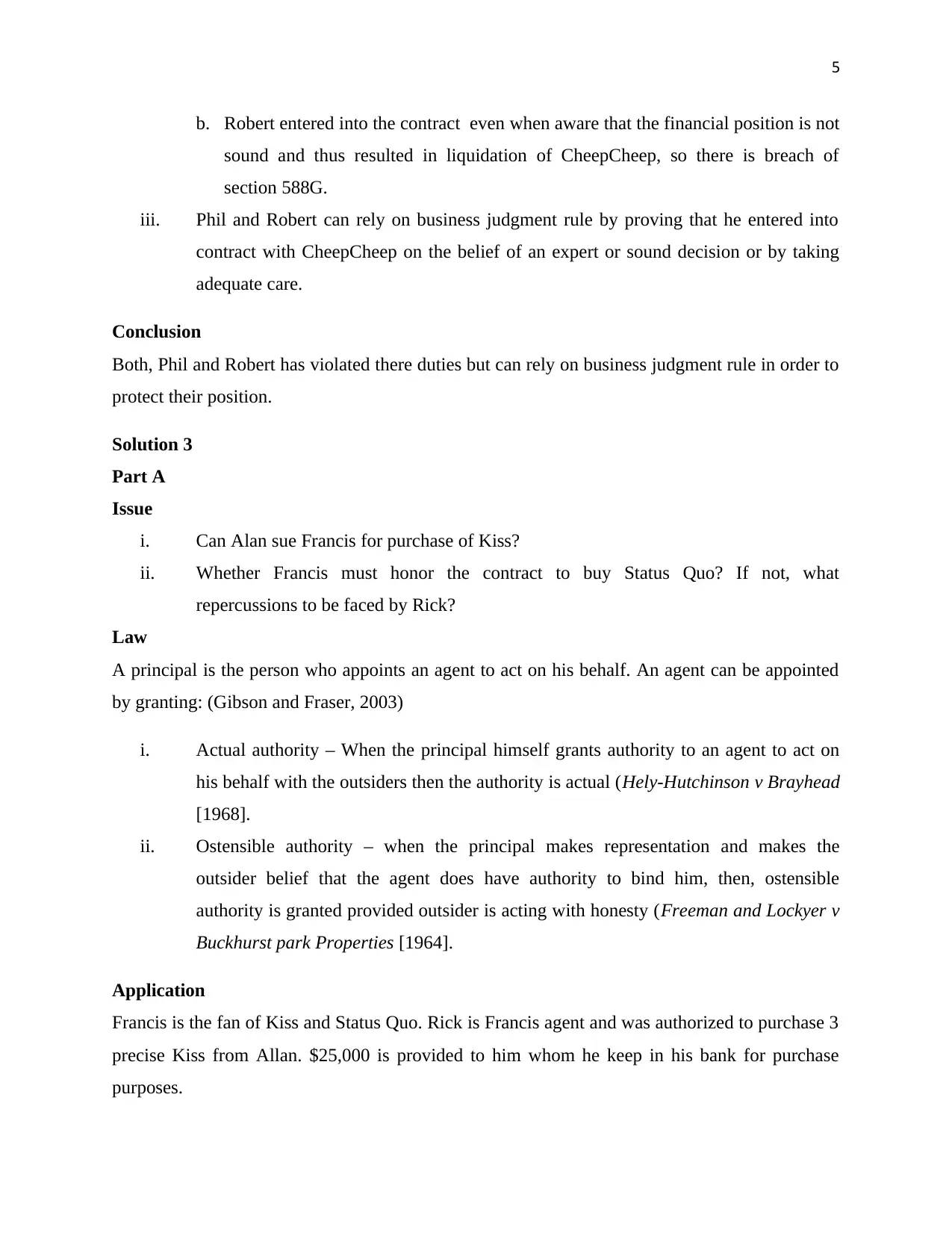
5
b. Robert entered into the contract even when aware that the financial position is not
sound and thus resulted in liquidation of CheepCheep, so there is breach of
section 588G.
iii. Phil and Robert can rely on business judgment rule by proving that he entered into
contract with CheepCheep on the belief of an expert or sound decision or by taking
adequate care.
Conclusion
Both, Phil and Robert has violated there duties but can rely on business judgment rule in order to
protect their position.
Solution 3
Part A
Issue
i. Can Alan sue Francis for purchase of Kiss?
ii. Whether Francis must honor the contract to buy Status Quo? If not, what
repercussions to be faced by Rick?
Law
A principal is the person who appoints an agent to act on his behalf. An agent can be appointed
by granting: (Gibson and Fraser, 2003)
i. Actual authority – When the principal himself grants authority to an agent to act on
his behalf with the outsiders then the authority is actual (Hely-Hutchinson v Brayhead
[1968].
ii. Ostensible authority – when the principal makes representation and makes the
outsider belief that the agent does have authority to bind him, then, ostensible
authority is granted provided outsider is acting with honesty (Freeman and Lockyer v
Buckhurst park Properties [1964].
Application
Francis is the fan of Kiss and Status Quo. Rick is Francis agent and was authorized to purchase 3
precise Kiss from Allan. $25,000 is provided to him whom he keep in his bank for purchase
purposes.
b. Robert entered into the contract even when aware that the financial position is not
sound and thus resulted in liquidation of CheepCheep, so there is breach of
section 588G.
iii. Phil and Robert can rely on business judgment rule by proving that he entered into
contract with CheepCheep on the belief of an expert or sound decision or by taking
adequate care.
Conclusion
Both, Phil and Robert has violated there duties but can rely on business judgment rule in order to
protect their position.
Solution 3
Part A
Issue
i. Can Alan sue Francis for purchase of Kiss?
ii. Whether Francis must honor the contract to buy Status Quo? If not, what
repercussions to be faced by Rick?
Law
A principal is the person who appoints an agent to act on his behalf. An agent can be appointed
by granting: (Gibson and Fraser, 2003)
i. Actual authority – When the principal himself grants authority to an agent to act on
his behalf with the outsiders then the authority is actual (Hely-Hutchinson v Brayhead
[1968].
ii. Ostensible authority – when the principal makes representation and makes the
outsider belief that the agent does have authority to bind him, then, ostensible
authority is granted provided outsider is acting with honesty (Freeman and Lockyer v
Buckhurst park Properties [1964].
Application
Francis is the fan of Kiss and Status Quo. Rick is Francis agent and was authorized to purchase 3
precise Kiss from Allan. $25,000 is provided to him whom he keep in his bank for purchase
purposes.
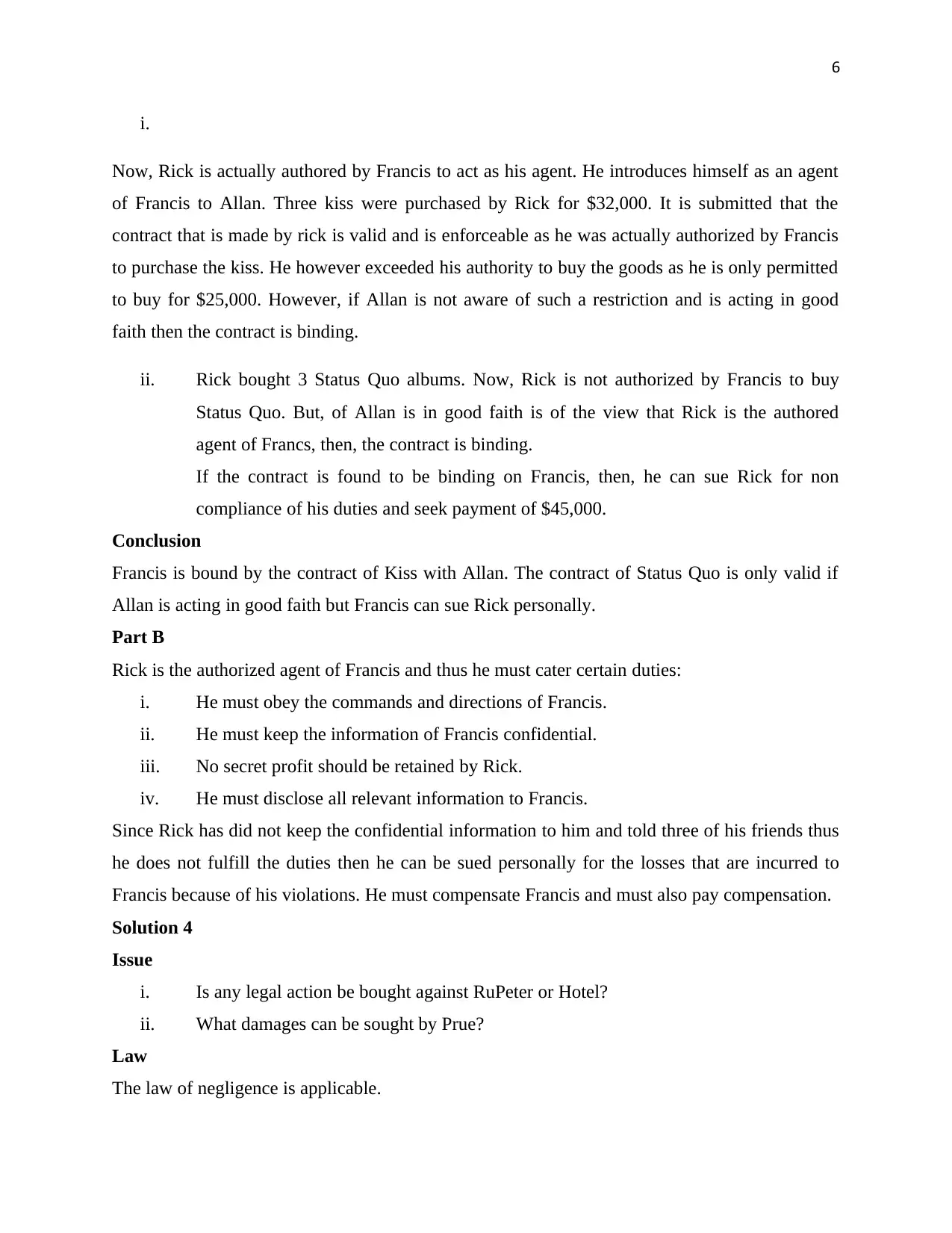
6
i.
Now, Rick is actually authored by Francis to act as his agent. He introduces himself as an agent
of Francis to Allan. Three kiss were purchased by Rick for $32,000. It is submitted that the
contract that is made by rick is valid and is enforceable as he was actually authorized by Francis
to purchase the kiss. He however exceeded his authority to buy the goods as he is only permitted
to buy for $25,000. However, if Allan is not aware of such a restriction and is acting in good
faith then the contract is binding.
ii. Rick bought 3 Status Quo albums. Now, Rick is not authorized by Francis to buy
Status Quo. But, of Allan is in good faith is of the view that Rick is the authored
agent of Francs, then, the contract is binding.
If the contract is found to be binding on Francis, then, he can sue Rick for non
compliance of his duties and seek payment of $45,000.
Conclusion
Francis is bound by the contract of Kiss with Allan. The contract of Status Quo is only valid if
Allan is acting in good faith but Francis can sue Rick personally.
Part B
Rick is the authorized agent of Francis and thus he must cater certain duties:
i. He must obey the commands and directions of Francis.
ii. He must keep the information of Francis confidential.
iii. No secret profit should be retained by Rick.
iv. He must disclose all relevant information to Francis.
Since Rick has did not keep the confidential information to him and told three of his friends thus
he does not fulfill the duties then he can be sued personally for the losses that are incurred to
Francis because of his violations. He must compensate Francis and must also pay compensation.
Solution 4
Issue
i. Is any legal action be bought against RuPeter or Hotel?
ii. What damages can be sought by Prue?
Law
The law of negligence is applicable.
i.
Now, Rick is actually authored by Francis to act as his agent. He introduces himself as an agent
of Francis to Allan. Three kiss were purchased by Rick for $32,000. It is submitted that the
contract that is made by rick is valid and is enforceable as he was actually authorized by Francis
to purchase the kiss. He however exceeded his authority to buy the goods as he is only permitted
to buy for $25,000. However, if Allan is not aware of such a restriction and is acting in good
faith then the contract is binding.
ii. Rick bought 3 Status Quo albums. Now, Rick is not authorized by Francis to buy
Status Quo. But, of Allan is in good faith is of the view that Rick is the authored
agent of Francs, then, the contract is binding.
If the contract is found to be binding on Francis, then, he can sue Rick for non
compliance of his duties and seek payment of $45,000.
Conclusion
Francis is bound by the contract of Kiss with Allan. The contract of Status Quo is only valid if
Allan is acting in good faith but Francis can sue Rick personally.
Part B
Rick is the authorized agent of Francis and thus he must cater certain duties:
i. He must obey the commands and directions of Francis.
ii. He must keep the information of Francis confidential.
iii. No secret profit should be retained by Rick.
iv. He must disclose all relevant information to Francis.
Since Rick has did not keep the confidential information to him and told three of his friends thus
he does not fulfill the duties then he can be sued personally for the losses that are incurred to
Francis because of his violations. He must compensate Francis and must also pay compensation.
Solution 4
Issue
i. Is any legal action be bought against RuPeter or Hotel?
ii. What damages can be sought by Prue?
Law
The law of negligence is applicable.
⊘ This is a preview!⊘
Do you want full access?
Subscribe today to unlock all pages.

Trusted by 1+ million students worldwide
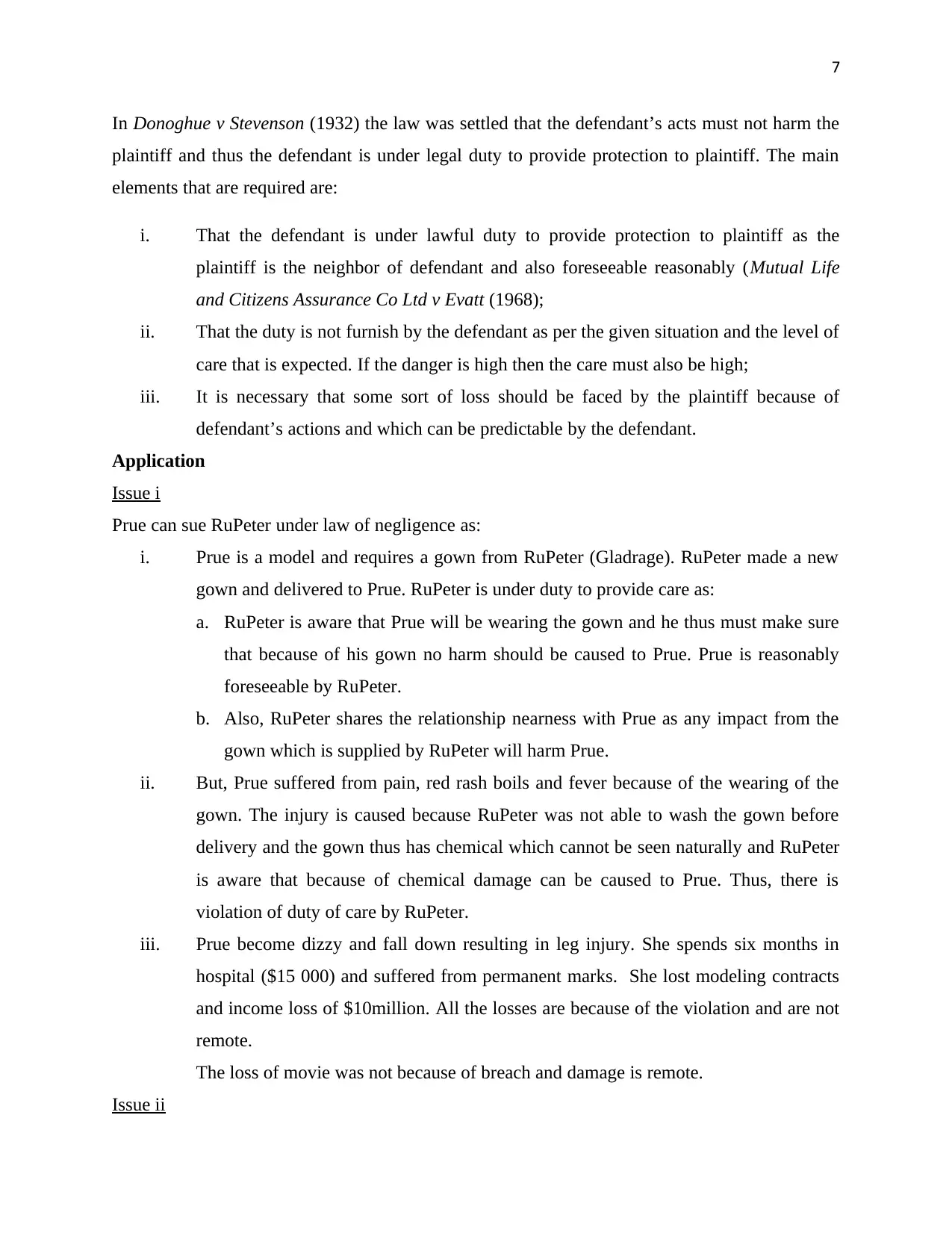
7
In Donoghue v Stevenson (1932) the law was settled that the defendant’s acts must not harm the
plaintiff and thus the defendant is under legal duty to provide protection to plaintiff. The main
elements that are required are:
i. That the defendant is under lawful duty to provide protection to plaintiff as the
plaintiff is the neighbor of defendant and also foreseeable reasonably (Mutual Life
and Citizens Assurance Co Ltd v Evatt (1968);
ii. That the duty is not furnish by the defendant as per the given situation and the level of
care that is expected. If the danger is high then the care must also be high;
iii. It is necessary that some sort of loss should be faced by the plaintiff because of
defendant’s actions and which can be predictable by the defendant.
Application
Issue i
Prue can sue RuPeter under law of negligence as:
i. Prue is a model and requires a gown from RuPeter (Gladrage). RuPeter made a new
gown and delivered to Prue. RuPeter is under duty to provide care as:
a. RuPeter is aware that Prue will be wearing the gown and he thus must make sure
that because of his gown no harm should be caused to Prue. Prue is reasonably
foreseeable by RuPeter.
b. Also, RuPeter shares the relationship nearness with Prue as any impact from the
gown which is supplied by RuPeter will harm Prue.
ii. But, Prue suffered from pain, red rash boils and fever because of the wearing of the
gown. The injury is caused because RuPeter was not able to wash the gown before
delivery and the gown thus has chemical which cannot be seen naturally and RuPeter
is aware that because of chemical damage can be caused to Prue. Thus, there is
violation of duty of care by RuPeter.
iii. Prue become dizzy and fall down resulting in leg injury. She spends six months in
hospital ($15 000) and suffered from permanent marks. She lost modeling contracts
and income loss of $10million. All the losses are because of the violation and are not
remote.
The loss of movie was not because of breach and damage is remote.
Issue ii
In Donoghue v Stevenson (1932) the law was settled that the defendant’s acts must not harm the
plaintiff and thus the defendant is under legal duty to provide protection to plaintiff. The main
elements that are required are:
i. That the defendant is under lawful duty to provide protection to plaintiff as the
plaintiff is the neighbor of defendant and also foreseeable reasonably (Mutual Life
and Citizens Assurance Co Ltd v Evatt (1968);
ii. That the duty is not furnish by the defendant as per the given situation and the level of
care that is expected. If the danger is high then the care must also be high;
iii. It is necessary that some sort of loss should be faced by the plaintiff because of
defendant’s actions and which can be predictable by the defendant.
Application
Issue i
Prue can sue RuPeter under law of negligence as:
i. Prue is a model and requires a gown from RuPeter (Gladrage). RuPeter made a new
gown and delivered to Prue. RuPeter is under duty to provide care as:
a. RuPeter is aware that Prue will be wearing the gown and he thus must make sure
that because of his gown no harm should be caused to Prue. Prue is reasonably
foreseeable by RuPeter.
b. Also, RuPeter shares the relationship nearness with Prue as any impact from the
gown which is supplied by RuPeter will harm Prue.
ii. But, Prue suffered from pain, red rash boils and fever because of the wearing of the
gown. The injury is caused because RuPeter was not able to wash the gown before
delivery and the gown thus has chemical which cannot be seen naturally and RuPeter
is aware that because of chemical damage can be caused to Prue. Thus, there is
violation of duty of care by RuPeter.
iii. Prue become dizzy and fall down resulting in leg injury. She spends six months in
hospital ($15 000) and suffered from permanent marks. She lost modeling contracts
and income loss of $10million. All the losses are because of the violation and are not
remote.
The loss of movie was not because of breach and damage is remote.
Issue ii
Paraphrase This Document
Need a fresh take? Get an instant paraphrase of this document with our AI Paraphraser
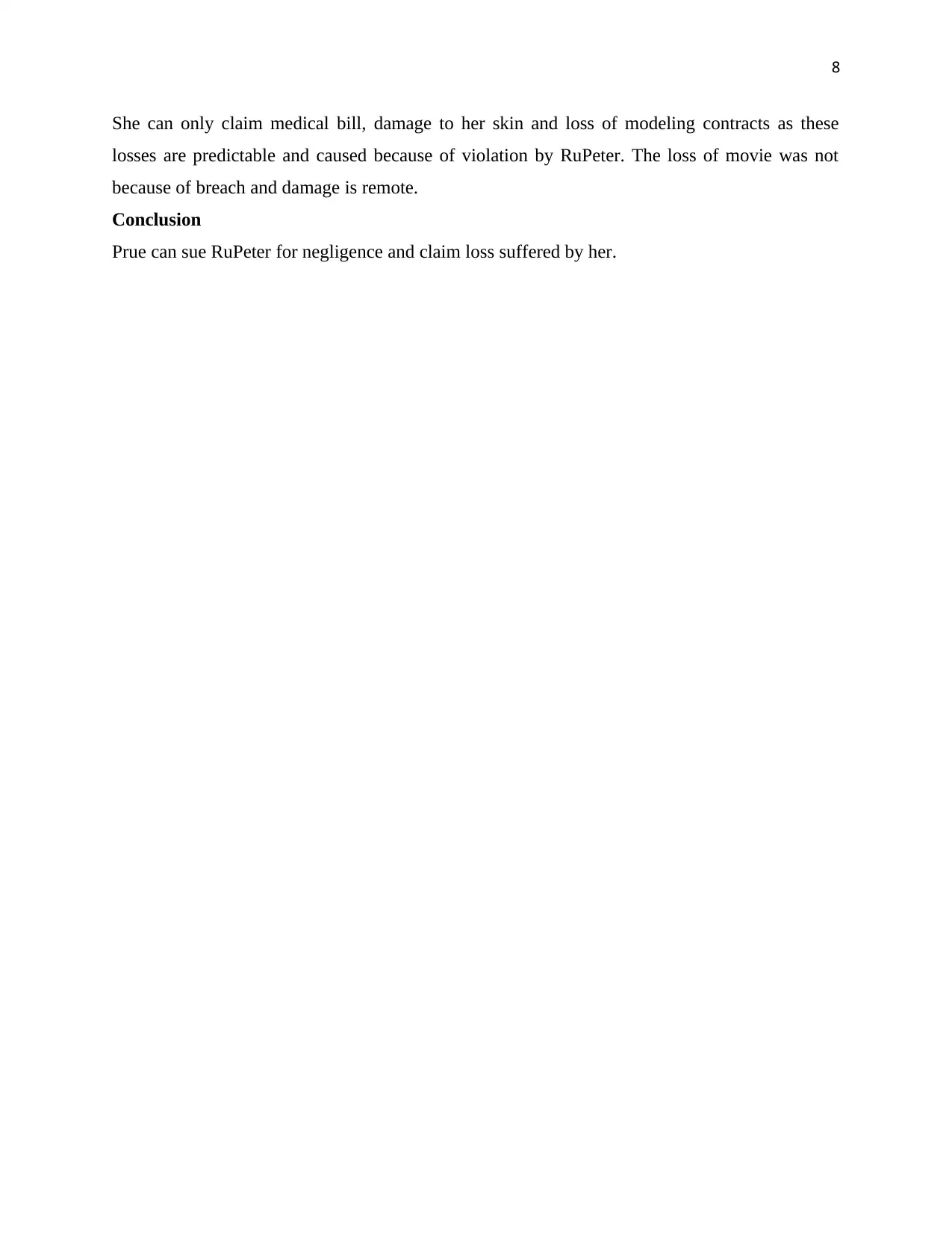
8
She can only claim medical bill, damage to her skin and loss of modeling contracts as these
losses are predictable and caused because of violation by RuPeter. The loss of movie was not
because of breach and damage is remote.
Conclusion
Prue can sue RuPeter for negligence and claim loss suffered by her.
She can only claim medical bill, damage to her skin and loss of modeling contracts as these
losses are predictable and caused because of violation by RuPeter. The loss of movie was not
because of breach and damage is remote.
Conclusion
Prue can sue RuPeter for negligence and claim loss suffered by her.
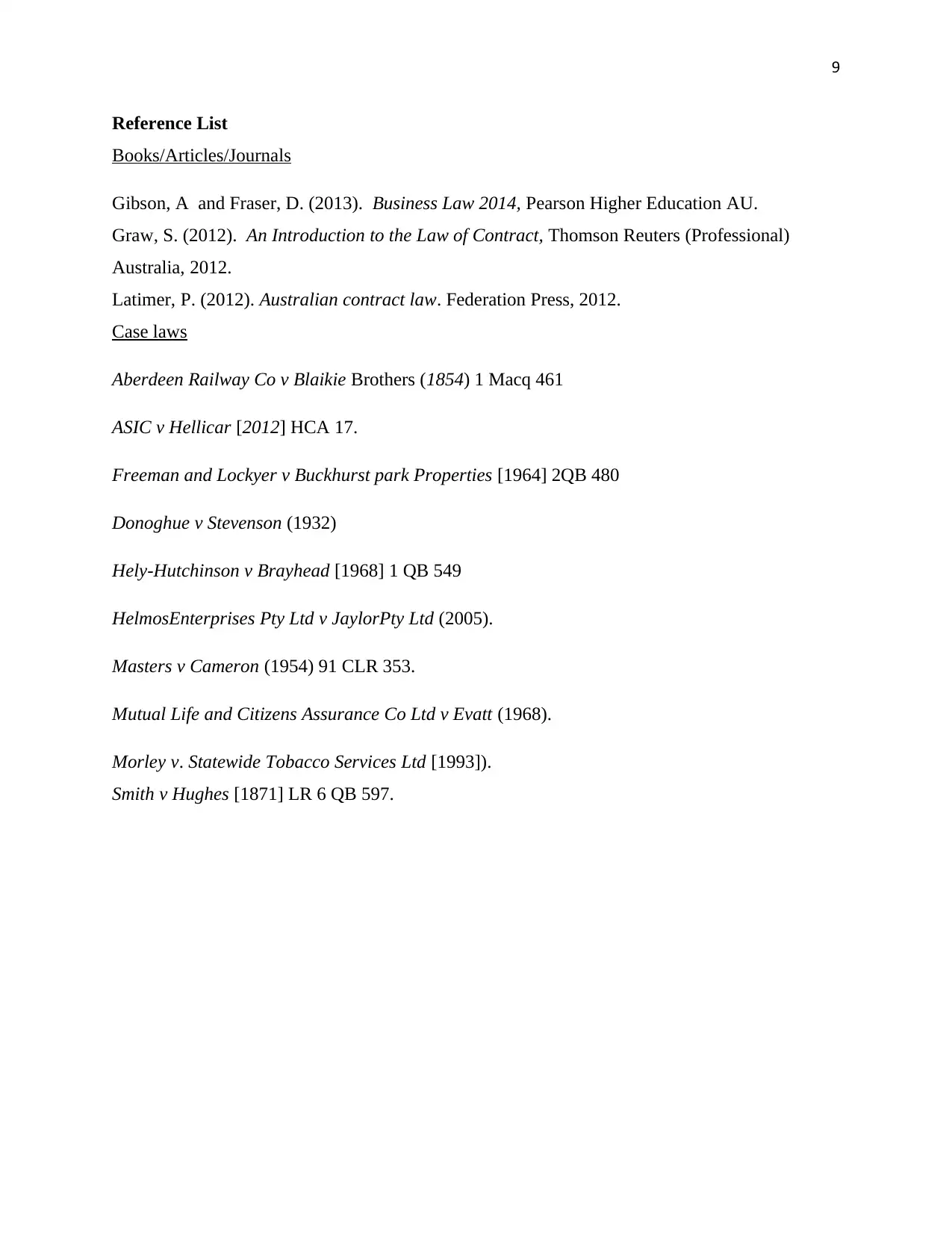
9
Reference List
Books/Articles/Journals
Gibson, A and Fraser, D. (2013). Business Law 2014, Pearson Higher Education AU.
Graw, S. (2012). An Introduction to the Law of Contract, Thomson Reuters (Professional)
Australia, 2012.
Latimer, P. (2012). Australian contract law. Federation Press, 2012.
Case laws
Aberdeen Railway Co v Blaikie Brothers (1854) 1 Macq 461
ASIC v Hellicar [2012] HCA 17.
Freeman and Lockyer v Buckhurst park Properties [1964] 2QB 480
Donoghue v Stevenson (1932)
Hely-Hutchinson v Brayhead [1968] 1 QB 549
HelmosEnterprises Pty Ltd v JaylorPty Ltd (2005).
Masters v Cameron (1954) 91 CLR 353.
Mutual Life and Citizens Assurance Co Ltd v Evatt (1968).
Morley v. Statewide Tobacco Services Ltd [1993]).
Smith v Hughes [1871] LR 6 QB 597.
Reference List
Books/Articles/Journals
Gibson, A and Fraser, D. (2013). Business Law 2014, Pearson Higher Education AU.
Graw, S. (2012). An Introduction to the Law of Contract, Thomson Reuters (Professional)
Australia, 2012.
Latimer, P. (2012). Australian contract law. Federation Press, 2012.
Case laws
Aberdeen Railway Co v Blaikie Brothers (1854) 1 Macq 461
ASIC v Hellicar [2012] HCA 17.
Freeman and Lockyer v Buckhurst park Properties [1964] 2QB 480
Donoghue v Stevenson (1932)
Hely-Hutchinson v Brayhead [1968] 1 QB 549
HelmosEnterprises Pty Ltd v JaylorPty Ltd (2005).
Masters v Cameron (1954) 91 CLR 353.
Mutual Life and Citizens Assurance Co Ltd v Evatt (1968).
Morley v. Statewide Tobacco Services Ltd [1993]).
Smith v Hughes [1871] LR 6 QB 597.
⊘ This is a preview!⊘
Do you want full access?
Subscribe today to unlock all pages.

Trusted by 1+ million students worldwide
1 out of 9
Related Documents
Your All-in-One AI-Powered Toolkit for Academic Success.
+13062052269
info@desklib.com
Available 24*7 on WhatsApp / Email
![[object Object]](/_next/static/media/star-bottom.7253800d.svg)
Unlock your academic potential
Copyright © 2020–2025 A2Z Services. All Rights Reserved. Developed and managed by ZUCOL.





